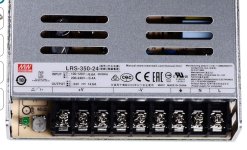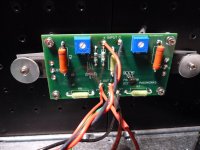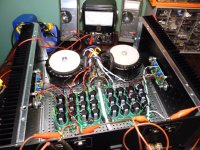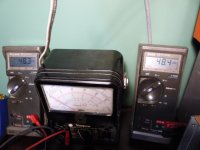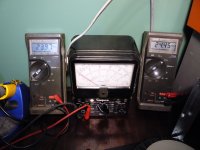Hi friends.
I just received a pair of Meanwell LRS-350-24 in the mail, and I plan to use them for the F5M. The LRS-350s are 5 dollars more expensive than the LRS-150's on Amazon, so I figured to use those instead. Not bad for $28 each.
I plan to do a pair of monoblocks with each of these connected to two Amy Alice SMPS boards.
I was planning to do a linear power supply, but Antek is out of all 300-400VA 18-20V Trafos, and the 200VA would force me to get a second power supply PSU. I may try a linear supply in the future, just doing this right now, to keep the projects moving along.
My question is, how can I modify the wiring/grounding that @lhquam did in this post for Monoblock's?
Best,
Jose
I just received a pair of Meanwell LRS-350-24 in the mail, and I plan to use them for the F5M. The LRS-350s are 5 dollars more expensive than the LRS-150's on Amazon, so I figured to use those instead. Not bad for $28 each.
I plan to do a pair of monoblocks with each of these connected to two Amy Alice SMPS boards.
I was planning to do a linear power supply, but Antek is out of all 300-400VA 18-20V Trafos, and the 200VA would force me to get a second power supply PSU. I may try a linear supply in the future, just doing this right now, to keep the projects moving along.
My question is, how can I modify the wiring/grounding that @lhquam did in this post for Monoblock's?
Best,
Jose
Attachments
You need TWO Meanwell SMPS per F5m channel if you’re planning on monoblocks. Each LRS will generate + or - 24VDC.
The tried and true method with Meanwell single supply SMPS is to connect two units in series for a +/- amp power supply. You could use your two LRS for +/-24VDC, but that would have to serve both of your F5m channels. Other manufacturers make dual rail SMPS, but they are typically more costly.
Yep, you found good evidence and rationale. I haven’t done this with Meanwell units yet, but others will be able to advise you.
Yep, you found good evidence and rationale. I haven’t done this with Meanwell units yet, but others will be able to advise you.
Last edited:
Excellent. No mono, unless I have an extra two, but two together can power a stereo pair! I was about to ask for the return label from amazon! 
Best,
Jose

Best,
Jose
A single SMPS should be able to create two rails right? There's multiple outputs. Am I mistaken here?
Certain models from Meanwell or other have dual polarity but most of the less expensive ones from Meanwell are single output.
With the usual Meanwells and others like them, they just have one output, with multiple connectors. It’s misleading. They are certainly single supply SMPS, with +VDC out and PGND (usually different than safety GND). Even though they label it as V+, V-, and GND.
A dual rail or differential SMPS will have +VDC, -VDC, and PGND.
Hopefully a data sheet will demonstrate if the SMPS is single rail or multiple.
A dual rail or differential SMPS will have +VDC, -VDC, and PGND.
Hopefully a data sheet will demonstrate if the SMPS is single rail or multiple.
Last edited:
Well that's not confusing at all. The SMPS has a +V and a -V, but they only can supply one rail? I think I've gone crosseyed.
No, it’s just how it’s labeled. On a typical MeanWell, V- is zero volts. It’s different from Ground, as that’s intended for safety earth. Also, V- is isolated from earth, hence the different designation.
Anywhoo, you need (2) MeanWell bricks to make a bipolar PSU, as previously mentioned. It works great.
Anywhoo, you need (2) MeanWell bricks to make a bipolar PSU, as previously mentioned. It works great.
@birdbox You haven’t. Their labeling is misleading. I agree with you, it’s confusing and annoying. 
In the picture, -V isn’t -VDC, it’s the power ground of a single supply. The earth symbol is for safety earth.
However, the Meanwells have been proven to work well in series to generate a true differential +/- supply. The link jacruzer provided earlier is a good example.
Edit, Jim uses the proper terminology. I’m just the average uneducated tinkerer that has been confused a lot.
I’m just the average uneducated tinkerer that has been confused a lot.

In the picture, -V isn’t -VDC, it’s the power ground of a single supply. The earth symbol is for safety earth.
However, the Meanwells have been proven to work well in series to generate a true differential +/- supply. The link jacruzer provided earlier is a good example.
Edit, Jim uses the proper terminology.
 I’m just the average uneducated tinkerer that has been confused a lot.
I’m just the average uneducated tinkerer that has been confused a lot.Attachments
The question revolves around whether V- is the same as earth ground.
Having earth isolated from V+ and V- is convenient for several reasons.
Having earth isolated from V+ and V- is convenient for several reasons.
I bought these days some sp-320-24 for my Gaincore. First I was using laptop bricks and everything was noise free.I just received a pair of Meanwell LRS-350-24
When I first installed them(the sp-320) I started to have low frequency noise in the speaker. Initially I though I had a gnd loop but later discovered that it was because I wasn’t using shielded wires between the preamp and amp.
just assembled an F5m kit and can not get bias voltage on either channel.I have obviously made an error but checks so far seem like I have the right components in the correct places.can anyone see an obvious mistake from the photos before I unsolder the boards and start component checks.Brought up the full voltage with a variac and no current draw or smoke.
Attachments
This should probably be moved to the F5m thread.
However, did you verify that the power supplies work, as in you can measure + and - 24V rails from both of them?
I can't see what's going on with the rectifiers.
However, did you verify that the power supplies work, as in you can measure + and - 24V rails from both of them?
I can't see what's going on with the rectifiers.
As soon as you post in the F5M thread there appears to be plenty of room to measure for the correct +/-24vdc. No power. No go.
I have +/-22 volts as I have used 16 volt AC secondary transformers but on the Variac I cranked the primary voltage a bit to achieve perfect secondary voltages of +/-24vdc and still no go.4 bridge rectifiers used two for each power supply board and jumpers installed as per instructions.center tap grounded to chassis.These are the voltages to the boards.
Attachments
So you can dial up the trimmer pots and you get 0VDC across the 0.47 ohm resistor(s)? You're measuring voltage there across R7 or R6, not current of course.
You confirmed the MOSFETs aren't backwards? I've made that mistake a couple times before.
You confirmed the MOSFETs aren't backwards? I've made that mistake a couple times before.
Last edited:
- Home
- Amplifiers
- Pass Labs
- Pass F5m

